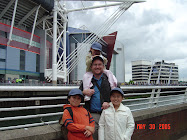The Cathedral at the Plaza de Bolivar
After Medellin, we went to Bogota and did a little bit of sightseeing. We were so spoiled in Medellin - the Actises were always there making sure that we were safe. However, Bogota provided us the freedom to go around even to the point of getting lost in the city and making our way back by asking, using the little Spanish that we know. We took taxis where ever we went. Most of the time, we would not understand how much we were supposed to pay. Fortunately, Shannon was there to translate for us.
Posing on the misty Mount Monserrate.
When we arrived in Bogota, I had the impression that the city looks desolate and frightening. Buildings that line the streets were closed. They have the rolled-down doors which made the place appear unfriendly. Tim and I walked around the hotel which is located in the heart of business area signs of life were missing. The sidewalks were without people. We could take a taxi but places that we wanted to go see were closed including the Museo Nacional de Colombia (which we visited later in the week). Well, to explain this phenomenon, we arrived there on a Sunday. Firstly, Colombia being a Catholic country closes on Sundays as a general rule. Secondly, Monday (June 27) was a holiday - I think it was Corpus Christi. Everything was still closed but we got to go eat at one of the two restaurants that were open near the hotel. We opted to try the Italian Restaurant instead of the Barbeque place. We must have been the only customers that night. Tuesday came and the city suddenly looked inhabited as if the people got up from a slumber and began to mill around the city once more. Suddenly the city exuded with life. Bogota is alive after all. Next time that we head to a new city, I would do my research and check the city calendar ahead of time. This reminds me of a different experience we had as a family. A few years ago, while traveling in Britain, we decided to take a quick train ride to Wales from Hereford. As soon as we got into the train, we knew something we didn't know was going on. There was a huge rugby game at the Millennium Stadium. It was quite an interesting experience. We were lucky that none of us was wearing the color of either team (use your imagination). Had we known, we would have chosen a different destination that day.
View od Bogota from the tramway.
Candellaria - Central District of Bogota.
Casa Santa Clara Restaurant
Station of the Cross at the Montserrate
Bogota rests on an altitude of about 10,300 ft. In spite of the fact that it rests along the equator, its temperature remains pleasantly cool or cold throughout the year. The fluctuation in the temperature and daylength in Colombia is negligible. This is the reason why Colombia is the place to grow flowers. Eighty percent of the cut flowers sold in the US are grown in Colombia near Bogota. Flower growers do not have to work around the changing seasons. If weather conditions were the only consideration for choosing a place to live, Bogota would be on the top of my list of choice cities. Unfortunately, there are more things to be accounted for before weather conditions.
Tramway
Colombian food is mild. We expected something like Mexican or Belizean food, but we were wrong. On the plane I got the chance to sit with a Colombian girl who was going home to visit her folks in Bogota. She told me to make sure that I'd try Ajiaco, a Bogotano signature dish. Basically, Ajiaco is a soup that is made of five varieties of potatoes. Each variety is supposed to add something different to the taste or texture of the soup. Chicken cubes are added to the soup and it is served with corn on cobb, cream, capers, salsa, avocado, and rice. I had Ajiaco Santa Fereno at the Embassy Suites and it was great. I can understand how it earned its status as a Colombian comfort food. On a side note, however, Californians might fail to appreciate the soup because they are no potato connoisseurs.
Feeding the doves can be very entertaining.
Juan Valdez - the Colombian counterpart of Starbucks.
My experience in Colombia defied all my expectations. I knew that the country is in the tropics where coffee (Coffea spp.), coca plants (Erythroxylum coca), roses, and other flowers. And that's about it; everything else came as a pleasant surprise for me.
Souvenir picture taken from Mount Montserrate.
Next time, I'll write about my observations and interactions with the people of Colombia.


































No comments:
Post a Comment
Leave a Response